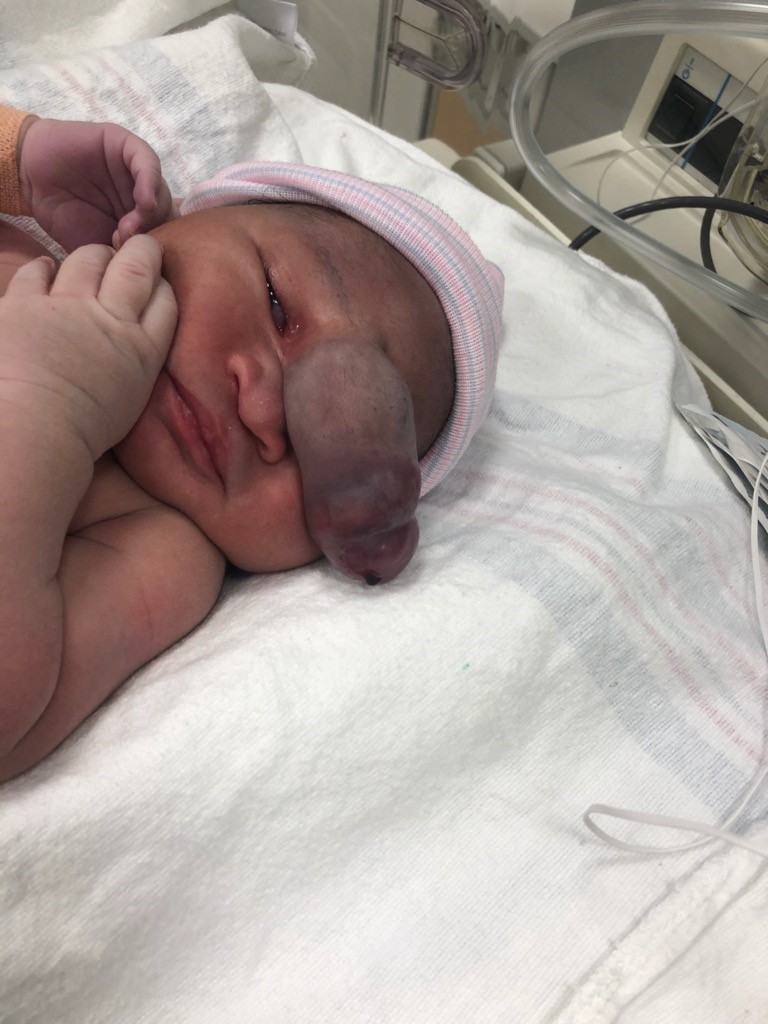A complex surgery saves a two-day-old baby’s life
Tuesday, February 16, 2021
A delicate, emergency surgery was required to repair a defect in the infant’s skull through which a significant part of the brain protruded.
Born with a large red bulge about the size of three stacked eggs protruding from between his eyes, the baby’s brain was jutting out of his skull. This rare malformation affects 1 in 10,000 births.
Numerous medical specialists at the Children’s, led by Neurosurgeon Dr. Roy Dudley, and Dr. Mirko Gilardino, Chief of the Division of Plastic Surgery and the Director of the H.B. Williams Craniofacial and Cleft Surgery Unit, were involved in the newborn’s care.
The original plan was to wait a few weeks to prepare for the surgery and to let the newborn gain strength. But the surgery became an emergency at two days of life when cerebrospinal fluid, the liquid that surrounds the brain, started to leak from the protrusion. This put the baby at high risk of meningitis, a potentially deadly brain infection.
The Children’s -- the best place to be when your child is seriously ill
The emergency surgery took place during a late afternoon in November, in an operating room crowded with various pediatric experts from neurosurgery, plastic surgery, anesthesia and nursing. As the Children’s is a teaching hospital, there were also McGill University medical students and residents observing or assisting. Everyone worked in harmony during the seven-hour procedure that saved the baby’s life.
 “It was not an easy surgery,” says Dr. Gilardino. “The baby was tiny, weighing only 3.17 kg and with a blood volume of about 500 ccs (two cups). For the Children’s excellent anesthesia team this surgery was a huge challenge because they had to keep the baby stable throughout a multi-step operation during which the infant required at least two complete blood transfusions.”
“It was not an easy surgery,” says Dr. Gilardino. “The baby was tiny, weighing only 3.17 kg and with a blood volume of about 500 ccs (two cups). For the Children’s excellent anesthesia team this surgery was a huge challenge because they had to keep the baby stable throughout a multi-step operation during which the infant required at least two complete blood transfusions.”
Dr. Dudley started by performing a craniotomy. He removed a portion of the baby’s skull to gain better access to the protrusion and the child’s brain. Expertise and a steady hand are required as there are many important arteries in this area of the brain and a mere nick of any one of them could be catastrophic.
“I removed the herniated brain because it is definitely abnormal and you can’t put it back inside the skull; it will only cause problems, like seizures,” explains Dr. Dudley. “The small amount of brain I removed was the most anterior part of the frontal lobe. In a newborn, this part does very little. So, over time, the rest of the brain will compensate.”
Dr. Gilardino stepped in next. “I had to work some plastic surgery magic to reconstruct the baby’s face. Due to the protrusion, the eye sockets had been displaced and the base of the nose including the nasal passages needed repositioning. My goal was to normalize the child’s appearance including, as much as possible, reducing the visibility of the scar on his face.”
Happily, the delicate surgery went very well and the baby is developing normally: eating well, following sights and sounds around the room, and smiling.
Going above and beyond for the young patients in our care
Going forward, the child will be followed by the Children’s Craniofacial team. When the baby is six or seven-years old, Dr. Gilardino may need to perform additional complex surgery to further narrow the gap between the child’s eyes and reconstruct the nose.
Both surgeons sincerely thank donors from the Children’s Foundation for their incredible support to both the Neurosurgery and the Craniofacial/Plastic Surgery teams. Donors are a vital member of the Children’s team. You help some of the sickest children in Quebec get back their fighting spirit. We couldn’t do it without you!
Thank you for helping the Children’s find unexpected ways to heal.
Find out more about the surgery and meet the surgeons in our webinar.